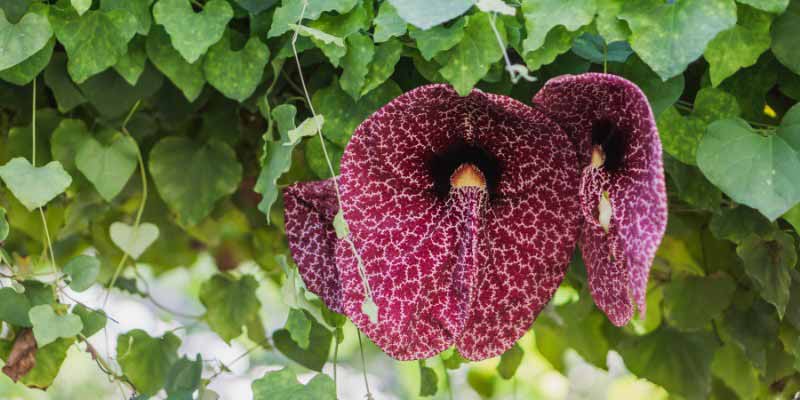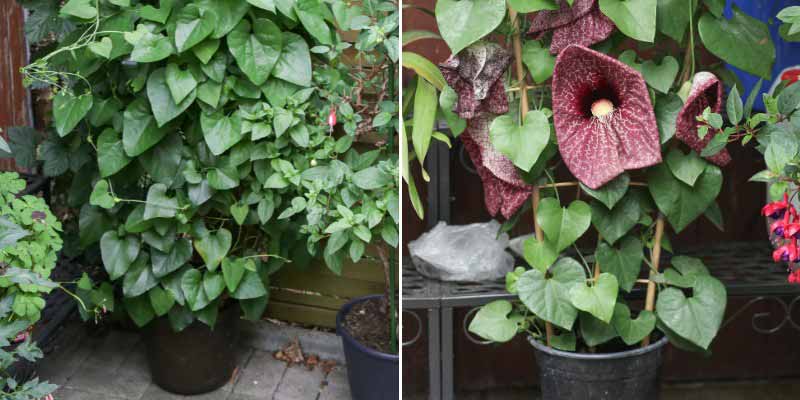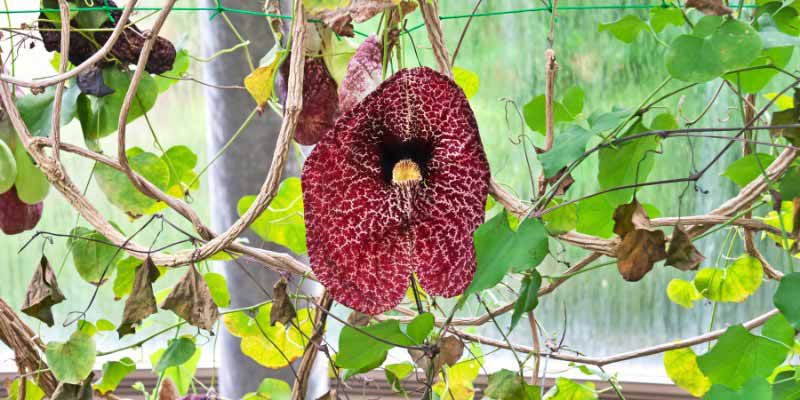Aristolochia (Aristolochia) is an attractive exotic liana notable for its large, heart-shaped foliage, which quickly covers walls, pergolas, fences and other supports. Its lush, abundant foliage turns beautiful colours in autumn. In summer, this liana reveals surprising siphon-shaped flowers in a deep purplish hue speckled with cream. It thrives in a sunny but not scorching position, or in part shade. Aristolochia durior or macrophylla and Aristolochia clematitis (Aristolochia clematitis) are species hardy enough (down to about -10 °C / -15 °C on average) to be grown outdoors in gardens in mild climates. In colder regions, they should be grown in pots on a balcony or terrace and must be protected from wind and cold in winter. Whether your Aristolochia is planted in ground or in a pot, it is essential to give it appropriate care before cold weather arrives. Find below the right steps to help it get through winter safely.
Why overwintering Aristolochia?
Aristolochia is easily grown outdoors in regions where temperatures do not fall below -10 °C, because it is sensitive to prolonged frost. This voluble liana dislikes very cold winters and icy winds, and can be weakened by severe freezing. That is why it should ideally be planted in a sheltered, south-facing spot, against a well-exposed wall, especially in less mild areas. Its foliage is particularly vulnerable to cold and can be destroyed once temperatures drop below -7 °C. However, if the stump is well established and well protected with a good mulch, it can survive down to -15 °C and will regrow in spring. The most frost-tender Aristolochias (down to -1 °C) should be grown all year in a heated conservatory or greenhouse and placed outdoors in summer. Overwintering therefore protects aerial parts (leaves and stems) and roots so they can survive and resume their growth in the following spring.

When to overwinter Aristolochia?
In regions with mild winters, Aristolochia can remain in ground throughout cold season. It only needs protection by adding a winter covering before first frosts, often around mid-October in northern France and around mid-November in the south. It is advisable to plan overwintering as soon as night temperatures regularly fall below 10 °C. For an Aristolochia in a pot, it is best to bring it under cover as soon as temperatures drop below 5 °C.
How to overwinter Aristolochia?
In ground
During first years after planting, and especially if you live in an area prone to frosts, it is essential to protect Aristolochia with winter protection. For an Aristolochia planted directly in garden, mulching is simplest and most effective method to keep its roots warm.
- Before first frosts: cover stump with a thick layer of mulch to protect from cold, straw or dead leaves.
- If severe frosts are forecast, also cover the aerial parts, without breaking branches, with a frost cloth which will also protect it from bad weather. Ventilate regularly on sunny days when there is no frost by removing frost cloth for a few hours.
In a pot
Aristolochia can be perfectly grown in a large pot, especially in colder zones, which makes it possible to store it in warmth. In autumn, bring pots under cover, into a greenhouse or heated conservatory. In winter, if temperatures do not fall below about -10 °C, or if pot cannot be moved indoors, you may leave Aristolochia outside for winter. Move it if necessary against a well-exposed wall and protect stump with a thick mulch. Roots of potted plants are more exposed to cold than those in ground. Wrap pot with insulating materials such as bubble wrap, hessian or an old blanket. Also raise it on wooden blocks, for example, to insulate from ground and protect roots from freezing. You can return it outdoors in spring, around May, once frost risk has passed.

Post-winter care
Here are key steps to care for your Aristolochia after winter:
1. Removing winter protection
As soon as frost risk has passed and temperatures begin to rise, gradually remove insulating materials (frost cloth, hessian on pot, etc.) used to protect plant. If you kept Aristolochia under cover, put it outside as soon as frost risk is over. This allows Aristolochia to benefit from spring light and warmth.
2. Watering
Resume regular watering as soon as plant shows signs of renewed growth. Ensure soil remains sufficiently cool but well drained to avoid root rot.
3. Feeding
Apply a good layer of well-rotted compost at foot of Aristolochia, lightly incorporate into soil by forking over.
4. Pruning
Inspect plant to remove parts damaged by frost or dead branches. Using a pruning shear, cut back dry, thin or dead stems at their base and shorten branches by two-thirds.
5. Repotting
If plant is in a pot, repot every 3 to 4 years into a slightly larger pot to accompany growth and renew substrate. In between, simply add a layer of fresh compost on surface to refresh nutrients (top-dressing).

































Comments